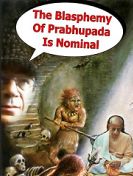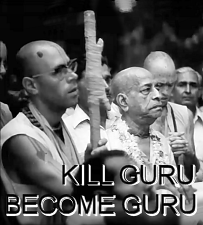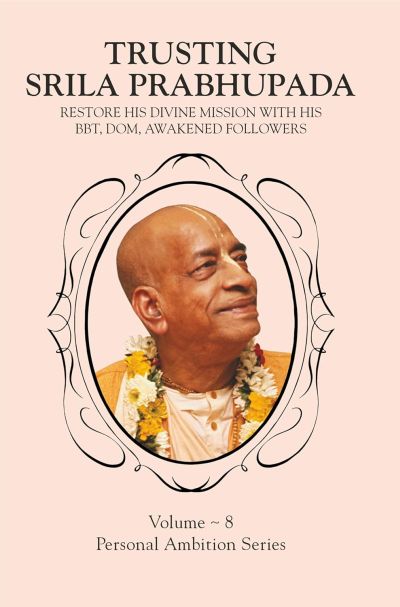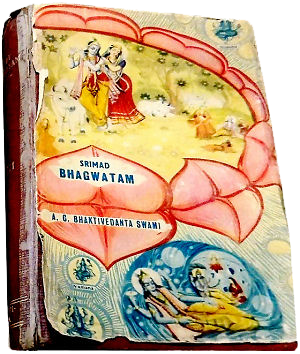Every living entity under the spell of material energy is held to be in an abnormal condition of madness. In Srimad-Bhagavatam it is said, “Generally, the conditioned soul is mad, because he is always engaged in activities which are the causes of bondage and suffering.” Spirit soul in his original condition is joyful, blissful, eternal and full of knowledge. Only by his implication in material activities has he become miserable, temporary and full of ignorance. This is due to vikarma. Vikarma means “actions which should not be done.” Therefore, we must practice sadhana-bhakti — which means to offer mangala-arati (Deity worship) in the morning, to refrain from certain material activities, to offer obeisances to the spiritual master and to follow many other rules and regulations which will be discussed here one after another. These practices will help one become cured of madness. As a man’s mental disease is cured by the directions of a psychiatrist, so this sadhana-bhakti cures the conditioned soul of his madness under the spell of maya, material illusion.
Narada Muni mentions this sadhana-bhakti in Srimad-Bhagavatam, Seventh Canto, First Chapter, verse 32. He says there to King Yudhisthira, “My dear King, one has to fix his mind on Krishna by any means.” That is called Krishna consciousness. It is the duty of the acarya, the spiritual master, to find the ways and means for his disciple to fix his mind on Krishna. That is the beginning of sadhana-bhakti.
Sri Caitanya Mahaprabhu has given us an authorized program for this purpose, centered around the chanting of the Hare Krishna mantra. This chanting has so much power that it immediately attaches one to Krishna. That is the beginning of sadhana-bhakti. Somehow or other, one has to fix his mind on Krishna. The great saint Ambarisa Maharaja, although a responsible king, fixed his mind on Krishna, and similarly anyone who tries to fix his mind in this way will very rapidly make progress in successfully reviving his original Krishna consciousness.
Now this sadhana-bhakti, or practice of devotional service, may also be divided into two parts. The first part is called service according to regulative principles: one has to follow these different regulative principles by the order of the spiritual master or on the strength of authoritative scriptures, and there can be no question of refusal. That is called vaidhi, or regulated. One has to do it without argument. Another part of sadhana-bhakti is called raganuga. Raganuga refers to the point at which, by following the regulative principles, one becomes a little more attached to Krishna and executes devotional service out of natural love. For example, a person engaged in devotional service may be ordered to rise early in the morning and offer arati, which is a form of Deity worship. In the beginning, by the order of his spiritual master, one rises early in the morning and offers arati, but then he develops real attachment. When he gets this attachment, he automatically tries to decorate the Deity and prepare different kinds of dresses and thinks of different plans to execute his devotional service nicely. Although it is within the category of practice, this offering of loving service is spontaneous. So the practice of devotional service, sadhana-bhakti, can be divided into two parts — namely, regulative and spontaneous.
Rupa Gosvami defines the first part of devotional practice, or vaidhi-bhakti, as follows: “When there is no attachment or no spontaneous loving service to the Lord, and one is engaged in the service of the Lord simply out of obedience to the order of the spiritual master or in pursuance of the scriptures, such obligatory service is called vaidhi-bhakti.”
These principles of vaidhi-bhakti are also described in Srimad-Bhagavatam, Second Canto, First Chapter, verse 5, where Sukadeva Gosvami instructs the dying Maharaja Pariksit as to his course of action. Maharaja Pariksit met Sukadeva Gosvami just a week before his death, and the King was perplexed as to what should be done before he was to pass on. Many other sages also arrived there, but no one could give him the proper direction. Sukadeva Gosvami, however, gave this direction to him as follows: “My dear King, if you want to be fearless in meeting your death next week for actually everyone is afraid at the point of death, then you must immediately begin the process of hearing and chanting and remembering God.” If one can chant and hear Hare Krishna and always remember Lord Krishna, then he is sure to become fearless of death, which may come at any moment.
In the statements of Sukadeva Gosvami it is said that the Supreme Personality of Godhead is Krishna. Therefore Sukadeva recommends that one should always hear about Krishna. He does not recommend that one hear and chant about the demigods. The Mayavadis (impersonalists) say that one may chant any name, either that of Krishna or those of the demigods, and the result will be the same. But actually this is not a fact. According to the authorized version of Srimad-Bhagavatam, one has to hear and chant about Lord Visnu (Krishna) only.
So Sukadeva Gosvami has recommended to Pariksit Maharaja that in order to be fearless of death, one has to hear and chant and remember the Supreme Personality of Godhead, Krishna, by all means. He also mentions that the Supreme Personality of Godhead is sarvatma. Sarvatma means “the Supersoul of everyone.” Krishna is also mentioned as isvara, the supreme controller who is situated in everyone’s heart. Therefore, if some way or other we become attached to Krishna, He will make us free from all danger. In Bhagavad-gita it is said that anyone who becomes a devotee of the Lord is never vanquished. Others, however, are always vanquished. “Vanquished” means that after getting this human form of life, a person does not come out of the entanglement of birth and death and thus misses his golden opportunity. Such a person does not know where he is being thrown by the laws of nature.








hare krisna! Dandvat to all. One obvious doubt appears that whom should one worship: visnu acc. to the srimad bhagvatam or krisna because two names are written to make one confused even if one leaves other demigods. Who is ultimate then. Please tell us. With regards.
pamho agtacbsp hare krsna anil kumara on the spiritual platform everything is absolute means there is not difference between krsna and his energies gauranga mahaprabhu brought this sublime philosophy called acintya abheda bheda tattva means that everything is krsna and in the same time different from krsna because we got the own individuality and krsna also got his supreme individuality that include all his the expansion our happiness is to see krsna to change different relationship with different devotees by reading srimad bhagavatam and the gita and by keeping reading by associate with guru sadhu and sastra and practice the 5 most important activities of our sadhana bhakti called chant mmhk at brahma muhurta time is from 4 to 7 am more or less that’s the best time then listen the bhagavatam class take darshan of the deties visit the holy places mentally and phisically if is possible and last one is to associate with sadhu people who are practise this kind of sadhana bhakti then everything will be very clear to you about this acintya abheda bheda tattva everyone is progressing therefore never giving up the hope that by chanting hare krsna we can become siddha purusa perfect devotees of gauranga mahaprabhu who is not different from radha krsna pranam ys seva das haribol